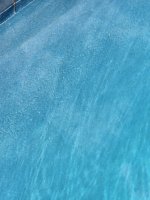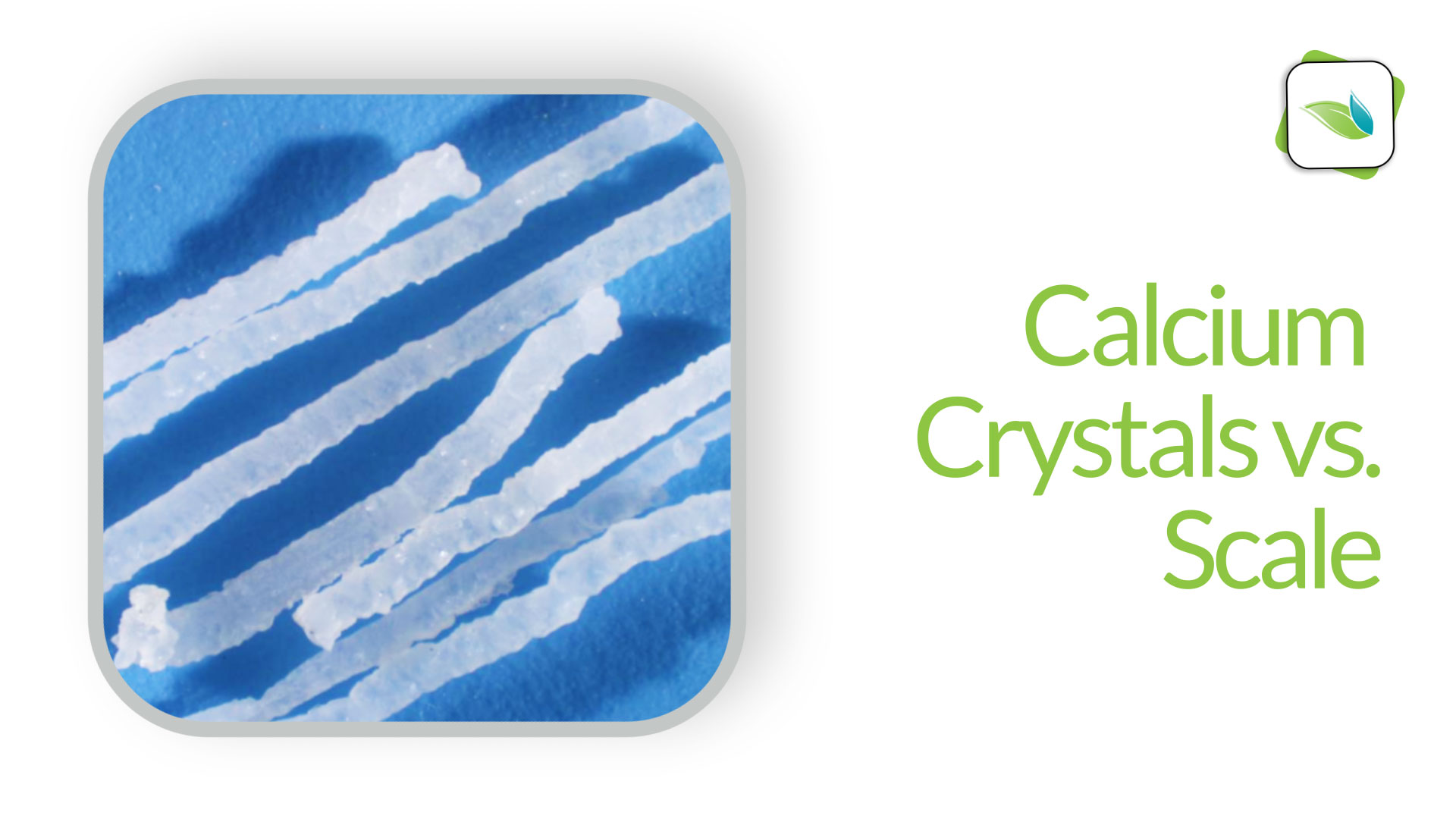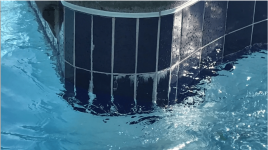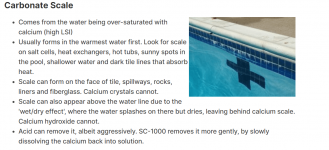In recent years, calcium crystals have been forming during the winter at a higher rate in some newly plastered swimming pools. From the reports we have heard, this problem seems to occur more often in the northeast of the country. Apparently, pool builders, plasterers, and service techs involved have not been able to determine the cause of these sharp and abrasive crystals and how to prevent them from forming on new plaster surfaces, including quartz and pebble.
(It should be noted that calcium crystals are different in appearance and form than the typical calcium scale that develops due to high pH and/or hard water), or calcium nodules that develop due to plaster delamination (bond failure) and in cracks.
Some think that the root cause of calcium crystal formation is aggressive water. More specifically, the theory is that some pools are not being properly winterized and adjusted for the soon-to-be lower and cold-water temperatures that can make water aggressive (See LSI). Also, that calcium from the plaster is being dissolved by aggressive water and then somehow that causes calcium crystals to start growing on the plaster surface.
That raises some questions. If aggressive water is dissolving calcium carbonate, how does it also form and grow calcium carbonate crystals at the same time? Has the plaster surface been analyzed for LSI aggressive water attack for confirmation? Why don’t all plaster pools with aggressive water develop crystals? Of course, aggressive water doesn't add up as a credible cause.
Let’s explore some other possibilities for this crystal phenomenon.
Plaster Issues
What is not widely known in our industry is that when plaster workmanship is poor, two forms of soluble calcium can dissolve out of new plaster, without the water even being aggressive. Yes, in water that is perfectly balanced. Those plaster components are calcium hydroxide, and calcium chloride. When those two compounds “bleed” into the pool water, that increases the pH, alkalinity, and calcium level. Those increases should not automatically be assumed to have been caused by LSI aggressive water. It may be due to poorly made plaster.
It is worthy to note that the concrete and cement industry (ACI and PCA) acknowledges that cement quality, or lack thereof, plays a huge role in the amount of efflorescence and/or dusting (among other problems and defects) that develops on new concrete finishes. They have identified high water content while mixing, high calcium chloride content, and poor troweling techniques (excessive water troweling) as reasons leading to a weak, porous, and micro-cracking cement finish. Those are issues that enable efflorescence (calcium) to form on cement surfaces. Is pool plaster much different?
Are some plasterers adding extra calcium chloride to plaster mixes during colder temperatures to speed up the plastering process, so that it doesn’t take all day? Does this lead to calcium hydroxide and calcium chloride dissolving out of plaster regardless of the water balance, thereby increasing the pH, alkalinity, and calcium levels? Could this be a recipe for calcium crystals to develop? Yes.
Chemical Start-up Issues
Differences in startup chemistry processes can have a significant impact on new plaster surfaces. For twenty-five years, onBalance’s Bicarb startup (Positive LSI startup) has shown to help prevent “plaster dust” from forming in new plaster pools. Would that startup program help negate crystal formation over the winter?
The NPC’s Traditional startup does NOT prevent plaster dust in newly plastered pools. In fact, it enables it. A lot of plaster dust means that the plaster surface has lost material and becomes more porous which can lead to more soluble plaster material being easily dissolved out. Does this startup program contribute to the crystal formation problem?
We all know that improper water chemistry can lead to various problems. But it is obvious that there are other issues (and the plaster itself) that need to be investigated and analyzed to determine the cause(s) and prevention of wintertime crystals.

(It should be noted that calcium crystals are different in appearance and form than the typical calcium scale that develops due to high pH and/or hard water), or calcium nodules that develop due to plaster delamination (bond failure) and in cracks.
Some think that the root cause of calcium crystal formation is aggressive water. More specifically, the theory is that some pools are not being properly winterized and adjusted for the soon-to-be lower and cold-water temperatures that can make water aggressive (See LSI). Also, that calcium from the plaster is being dissolved by aggressive water and then somehow that causes calcium crystals to start growing on the plaster surface.
That raises some questions. If aggressive water is dissolving calcium carbonate, how does it also form and grow calcium carbonate crystals at the same time? Has the plaster surface been analyzed for LSI aggressive water attack for confirmation? Why don’t all plaster pools with aggressive water develop crystals? Of course, aggressive water doesn't add up as a credible cause.
Let’s explore some other possibilities for this crystal phenomenon.
Plaster Issues
What is not widely known in our industry is that when plaster workmanship is poor, two forms of soluble calcium can dissolve out of new plaster, without the water even being aggressive. Yes, in water that is perfectly balanced. Those plaster components are calcium hydroxide, and calcium chloride. When those two compounds “bleed” into the pool water, that increases the pH, alkalinity, and calcium level. Those increases should not automatically be assumed to have been caused by LSI aggressive water. It may be due to poorly made plaster.
It is worthy to note that the concrete and cement industry (ACI and PCA) acknowledges that cement quality, or lack thereof, plays a huge role in the amount of efflorescence and/or dusting (among other problems and defects) that develops on new concrete finishes. They have identified high water content while mixing, high calcium chloride content, and poor troweling techniques (excessive water troweling) as reasons leading to a weak, porous, and micro-cracking cement finish. Those are issues that enable efflorescence (calcium) to form on cement surfaces. Is pool plaster much different?
Are some plasterers adding extra calcium chloride to plaster mixes during colder temperatures to speed up the plastering process, so that it doesn’t take all day? Does this lead to calcium hydroxide and calcium chloride dissolving out of plaster regardless of the water balance, thereby increasing the pH, alkalinity, and calcium levels? Could this be a recipe for calcium crystals to develop? Yes.
Chemical Start-up Issues
Differences in startup chemistry processes can have a significant impact on new plaster surfaces. For twenty-five years, onBalance’s Bicarb startup (Positive LSI startup) has shown to help prevent “plaster dust” from forming in new plaster pools. Would that startup program help negate crystal formation over the winter?
The NPC’s Traditional startup does NOT prevent plaster dust in newly plastered pools. In fact, it enables it. A lot of plaster dust means that the plaster surface has lost material and becomes more porous which can lead to more soluble plaster material being easily dissolved out. Does this startup program contribute to the crystal formation problem?
We all know that improper water chemistry can lead to various problems. But it is obvious that there are other issues (and the plaster itself) that need to be investigated and analyzed to determine the cause(s) and prevention of wintertime crystals.

Last edited:



.png)

